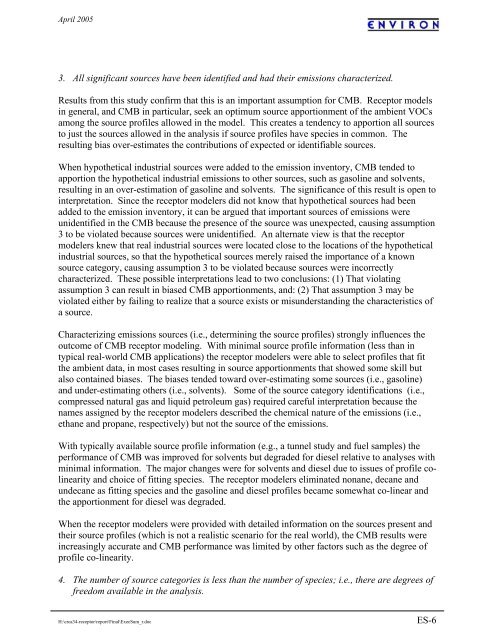CRC Report No. A-34 - Coordinating Research Council
CRC Report No. A-34 - Coordinating Research Council
CRC Report No. A-34 - Coordinating Research Council
Create successful ePaper yourself
Turn your PDF publications into a flip-book with our unique Google optimized e-Paper software.
April 2005<br />
3. All significant sources have been identified and had their emissions characterized.<br />
Results from this study confirm that this is an important assumption for CMB. Receptor models<br />
in general, and CMB in particular, seek an optimum source apportionment of the ambient VOCs<br />
among the source profiles allowed in the model. This creates a tendency to apportion all sources<br />
to just the sources allowed in the analysis if source profiles have species in common. The<br />
resulting bias over-estimates the contributions of expected or identifiable sources.<br />
When hypothetical industrial sources were added to the emission inventory, CMB tended to<br />
apportion the hypothetical industrial emissions to other sources, such as gasoline and solvents,<br />
resulting in an over-estimation of gasoline and solvents. The significance of this result is open to<br />
interpretation. Since the receptor modelers did not know that hypothetical sources had been<br />
added to the emission inventory, it can be argued that important sources of emissions were<br />
unidentified in the CMB because the presence of the source was unexpected, causing assumption<br />
3 to be violated because sources were unidentified. An alternate view is that the receptor<br />
modelers knew that real industrial sources were located close to the locations of the hypothetical<br />
industrial sources, so that the hypothetical sources merely raised the importance of a known<br />
source category, causing assumption 3 to be violated because sources were incorrectly<br />
characterized. These possible interpretations lead to two conclusions: (1) That violating<br />
assumption 3 can result in biased CMB apportionments, and: (2) That assumption 3 may be<br />
violated either by failing to realize that a source exists or misunderstanding the characteristics of<br />
a source.<br />
Characterizing emissions sources (i.e., determining the source profiles) strongly influences the<br />
outcome of CMB receptor modeling. With minimal source profile information (less than in<br />
typical real-world CMB applications) the receptor modelers were able to select profiles that fit<br />
the ambient data, in most cases resulting in source apportionments that showed some skill but<br />
also contained biases. The biases tended toward over-estimating some sources (i.e., gasoline)<br />
and under-estimating others (i.e., solvents). Some of the source category identifications (i.e.,<br />
compressed natural gas and liquid petroleum gas) required careful interpretation because the<br />
names assigned by the receptor modelers described the chemical nature of the emissions (i.e.,<br />
ethane and propane, respectively) but not the source of the emissions.<br />
With typically available source profile information (e.g., a tunnel study and fuel samples) the<br />
performance of CMB was improved for solvents but degraded for diesel relative to analyses with<br />
minimal information. The major changes were for solvents and diesel due to issues of profile colinearity<br />
and choice of fitting species. The receptor modelers eliminated nonane, decane and<br />
undecane as fitting species and the gasoline and diesel profiles became somewhat co-linear and<br />
the apportionment for diesel was degraded.<br />
When the receptor modelers were provided with detailed information on the sources present and<br />
their source profiles (which is not a realistic scenario for the real world), the CMB results were<br />
increasingly accurate and CMB performance was limited by other factors such as the degree of<br />
profile co-linearity.<br />
4. The number of source categories is less than the number of species; i.e., there are degrees of<br />
freedom available in the analysis.<br />
H:\crca<strong>34</strong>-receptor\report\Final\ExecSum_r.doc<br />
ES-6
















